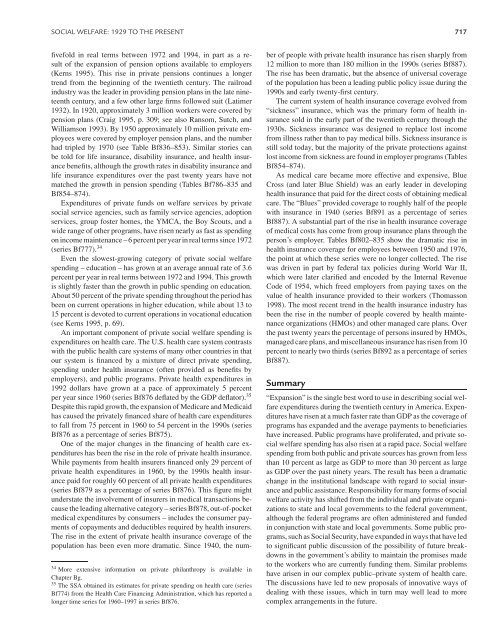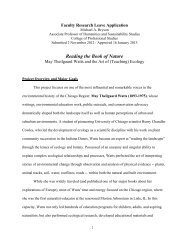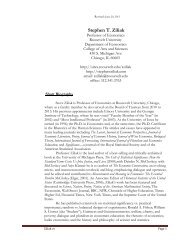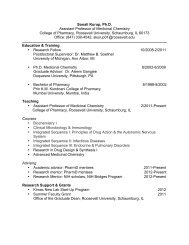Social Insurance and Public Assistance
public-assistance-welfare-reform-colonial-times-to-the-present-ziliak ...
public-assistance-welfare-reform-colonial-times-to-the-present-ziliak ...
You also want an ePaper? Increase the reach of your titles
YUMPU automatically turns print PDFs into web optimized ePapers that Google loves.
SOCIAL WELFARE: 1929 TO THE PRESENT 717<br />
fivefold in real terms between 1972 <strong>and</strong> 1994, in part as a result<br />
of the expansion of pension options available to employers<br />
(Kerns 1995). This rise in private pensions continues a longer<br />
trend from the beginning of the twentieth century. The railroad<br />
industry was the leader in providing pension plans in the late nineteenth<br />
century, <strong>and</strong> a few other large firms followed suit (Latimer<br />
1932). In 1920, approximately 3 million workers were covered by<br />
pension plans (Craig 1995, p. 309; see also Ransom, Sutch, <strong>and</strong><br />
Williamson 1993). By 1950 approximately 10 million private employees<br />
were covered by employer pension plans, <strong>and</strong> the number<br />
had tripled by 1970 (see Table Bf836–853). Similar stories can<br />
be told for life insurance, disability insurance, <strong>and</strong> health insurance<br />
benefits, although the growth rates in disability insurance <strong>and</strong><br />
life insurance expenditures over the past twenty years have not<br />
matched the growth in pension spending (Tables Bf786–835 <strong>and</strong><br />
Bf854–874).<br />
Expenditures of private funds on welfare services by private<br />
social service agencies, such as family service agencies, adoption<br />
services, group foster homes, the YMCA, the Boy Scouts, <strong>and</strong> a<br />
wide range of other programs, have risen nearly as fast as spending<br />
on income maintenance – 6 percent per year in real terms since 1972<br />
(series Bf777). 34<br />
Even the slowest-growing category of private social welfare<br />
spending – education – has grown at an average annual rate of 3.6<br />
percent per year in real terms between 1972 <strong>and</strong> 1994. This growth<br />
is slightly faster than the growth in public spending on education.<br />
About 50 percent of the private spending throughout the period has<br />
been on current operations in higher education, while about 13 to<br />
15 percent is devoted to current operations in vocational education<br />
(see Kerns 1995, p. 69).<br />
An important component of private social welfare spending is<br />
expenditures on health care. The U.S. health care system contrasts<br />
with the public health care systems of many other countries in that<br />
our system is financed by a mixture of direct private spending,<br />
spending under health insurance (often provided as benefits by<br />
employers), <strong>and</strong> public programs. Private health expenditures in<br />
1992 dollars have grown at a pace of approximately 5 percent<br />
per year since 1960 (series Bf876 deflated by the GDP deflator). 35<br />
Despite this rapid growth, the expansion of Medicare <strong>and</strong> Medicaid<br />
has caused the privately financed share of health care expenditures<br />
to fall from 75 percent in 1960 to 54 percent in the 1990s (series<br />
Bf876 as a percentage of series Bf875).<br />
One of the major changes in the financing of health care expenditures<br />
has been the rise in the role of private health insurance.<br />
While payments from health insurers financed only 29 percent of<br />
private health expenditures in 1960, by the 1990s health insurance<br />
paid for roughly 60 percent of all private health expenditures<br />
(series Bf879 as a percentage of series Bf876). This figure might<br />
understate the involvement of insurers in medical transactions because<br />
the leading alternative category – series Bf878, out-of-pocket<br />
medical expenditures by consumers – includes the consumer payments<br />
of copayments <strong>and</strong> deductibles required by health insurers.<br />
The rise in the extent of private health insurance coverage of the<br />
population has been even more dramatic. Since 1940, the num-<br />
34 More extensive information on private philanthropy is available in<br />
Chapter Bg.<br />
35 The SSA obtained its estimates for private spending on health care (series<br />
Bf774) from the Health Care Financing Administration, which has reported a<br />
longer time series for 1960–1997 in series Bf876.<br />
ber of people with private health insurance has risen sharply from<br />
12 million to more than 180 million in the 1990s (series Bf887).<br />
The rise has been dramatic, but the absence of universal coverage<br />
of the population has been a leading public policy issue during the<br />
1990s <strong>and</strong> early twenty-first century.<br />
The current system of health insurance coverage evolved from<br />
“sickness” insurance, which was the primary form of health insurance<br />
sold in the early part of the twentieth century through the<br />
1930s. Sickness insurance was designed to replace lost income<br />
from illness rather than to pay medical bills. Sickness insurance is<br />
still sold today, but the majority of the private protections against<br />
lost income from sickness are found in employer programs (Tables<br />
Bf854–874).<br />
As medical care became more effective <strong>and</strong> expensive, Blue<br />
Cross (<strong>and</strong> later Blue Shield) was an early leader in developing<br />
health insurance that paid for the direct costs of obtaining medical<br />
care. The “Blues” provided coverage to roughly half of the people<br />
with insurance in 1940 (series Bf891 as a percentage of series<br />
Bf887). A substantial part of the rise in health insurance coverage<br />
of medical costs has come from group insurance plans through the<br />
person’s employer. Tables Bf802–835 show the dramatic rise in<br />
health insurance coverage for employees between 1950 <strong>and</strong> 1976,<br />
the point at which these series were no longer collected. The rise<br />
was driven in part by federal tax policies during World War II,<br />
which were later clarified <strong>and</strong> encoded by the Internal Revenue<br />
Code of 1954, which freed employers from paying taxes on the<br />
value of health insurance provided to their workers (Thomasson<br />
1998). The most recent trend in the health insurance industry has<br />
been the rise in the number of people covered by health maintenance<br />
organizations (HMOs) <strong>and</strong> other managed care plans. Over<br />
the past twenty years the percentage of persons insured by HMOs,<br />
managed care plans, <strong>and</strong> miscellaneous insurance has risen from 10<br />
percent to nearly two thirds (series Bf892 as a percentage of series<br />
Bf887).<br />
Summary<br />
“Expansion” is the single best word to use in describing social welfare<br />
expenditures during the twentieth century in America. Expenditures<br />
have risen at a much faster rate than GDP as the coverage of<br />
programs has exp<strong>and</strong>ed <strong>and</strong> the average payments to beneficiaries<br />
have increased. <strong>Public</strong> programs have proliferated, <strong>and</strong> private social<br />
welfare spending has also risen at a rapid pace. <strong>Social</strong> welfare<br />
spending from both public <strong>and</strong> private sources has grown from less<br />
than 10 percent as large as GDP to more than 30 percent as large<br />
as GDP over the past ninety years. The result has been a dramatic<br />
change in the institutional l<strong>and</strong>scape with regard to social insurance<br />
<strong>and</strong> public assistance. Responsibility for many forms of social<br />
welfare activity has shifted from the individual <strong>and</strong> private organizations<br />
to state <strong>and</strong> local governments to the federal government,<br />
although the federal programs are often administered <strong>and</strong> funded<br />
in conjunction with state <strong>and</strong> local governments. Some public programs,<br />
such as <strong>Social</strong> Security, have exp<strong>and</strong>ed in ways that have led<br />
to significant public discussion of the possibility of future breakdowns<br />
in the government’s ability to maintain the promises made<br />
to the workers who are currently funding them. Similar problems<br />
have arisen in our complex public–private system of health care.<br />
The discussions have led to new proposals of innovative ways of<br />
dealing with these issues, which in turn may well lead to more<br />
complex arrangements in the future.









